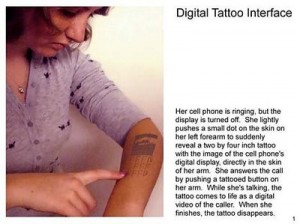Get ready for gadgets to work under your skin
Left your cell phone at home again? A solution is at hand: Make sure it’s with you at all times by having it implanted in your arm. But given the opportunity, would you want your gadget to be a permanent part of you? The question may need answering sooner than you think.

The Google Glass Project. Singularity is no longer the realm of fantasy and science fiction. Billions of dollars now being spent to merge man and machine into an unholy mess foretold in the bible.
Researchers at Autodesk, a software company in Toronto, Canada, checked to see whether the methods we currently use to interface with our gadgets work when the device is implanted in human tissue. The answer was a resounding “yes.”
A button, an LED and a touch sensor all functioned appropriately when embedded under the skin of a cadaver’s arm. The team was even able to communicate transcutaneously using a Bluetooth connection and charge the electronics wirelessly.
“That’s the bottom line,” says Christian Holz of the Autodesk team, who presented the work in May at the Conference on Human Factors in Computing Systems in Austin, Texas. “Traditional user interfaces work through the skin.”
Would anyone want a piece of consumer electronics inside their body? There is something intrinsically creepy about the idea. Plus there’s a risk that the device could malfunction and need to be removed, or that it could infect the surrounding tissue, not to mention the dystopian vision of a society in which our phones become tracking devices that we can never be free of.
Yet there are reasons for thinking that the cyborg future will come to be. The research team, who worked with University of Toronto anatomist Anne Agur, says that medical risks, such as infection, need to be better understood before a device can be implanted into a living person. But it’s a problem that manufacturers of existing implants, such as stents and replacement hips, have successfully tackled.
Clear Benefits?
There are also clear benefits to implanted electronics.
“The device is always there,” says Holz. “You cannot lose it.” And implants provide new interface methods. A gadget similar to a smartphone could provide a calendar alert by means of a gentle sub-skin vibration, for example.

One of the many prototypes of future cell phone applications is an implanted cell phone with a digital tattoo interface. This was entered in the 2008 Greener Gadgets Competition. (Image source: Gizmodo.com.au)
And that creepy feeling? It is a common reaction now, but may lessen as people become familiar with the technology.
The idea of using a machine to assist a human heart was once deemed unnatural, for example, but the insertion of a pacemaker is now a routine procedure.
“In general, the trend has been that people are more and more willing to incorporate bits of the machine world into themselves,” says Sherry Turkle, a sociologist at the Massachusetts Institute of Technology.
“The perception (of this technology) 10 years ago would differ from today and from what we would get in 10 years’ time,” agrees Holz.
Turkle wants society to think seriously about the potential downsides of implanted electronics, including tracking. But she has also studied how people relate to their cellphones and notes that some talk about them as if they were cyborgs.
“People literally cannot be without this device,” Turkle says. “They don’t feel the same when they are not connected. We live with our phones as if they are part of our body.”
If we feel that way, perhaps having a phone implanted isn’t unnatural at all. It may just be the obvious thing to do with a device that we already feel highly attached to. – Source – JewishWorldReview
You need to be a member of 12160 Social Network to add comments!
Join 12160 Social Network